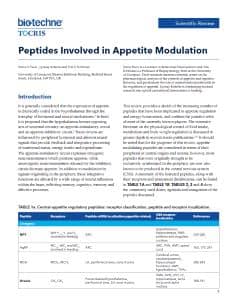Melanocortin (MC) Receptors
Melanocortin receptors are activated by members of the melanocortin family: α-, β- and γ-melanocyte stimulating hormone (MSH) and adrenocorticotropic hormone (ACTH). The melanocortins are involved in a range of physiological functions, including pigmentation and inflammation.
Melanocortin (MC) Receptor Agonists |
|
|---|---|
| Cat. No. | Product Name / Activity |
| 3492 | ACTH (1-39) |
| Potent endogenous MC2 agonist | |
| 2566 | Melanotan II |
| High affinity melanocortin receptor agonist | |
| 3013 | [Nle4,D-Phe7]-α-MSH |
| Melanocortin receptor agonist | |
| 2584 | α-MSH |
| Endogenous melanocortin receptor agonist | |
| 3032 | THIQ |
| Potent and selective MC4 receptor agonist | |
Melanocortin (MC) Receptor Antagonists |
|
| Cat. No. | Product Name / Activity |
| 1831 | HS 014 |
| Selective MC4 receptor antagonist | |
| 1832 | HS 024 |
| Highly potent MC4 receptor antagonist | |
| 4854 | ML 00253764 hydrochloride |
| Melanocortin MC4 receptor antagonist; brain penetrant | |
Other |
|
| Cat. No. | Product Name / Activity |
| 3420 | SHU 9119 |
| MC3 and MC4 antagonist; MC5 partial agonist | |
Melanocortin receptors are activated by members of the melanocortin family: α-, β- and γ-melanocyte stimulating hormone (MSH) and adrenocorticotropic hormone (ACTH). Endogenous antagonists include agouti and agouti-related protein (AgRP). The melanocortin receptors are G-protein-coupled and 5 subtypes exist, MC1-5. The melanocortins are involved in a wide range of physiological functions, including pigmentation, energy homeostasis, inflammation, immunomodulation, steroidogenesis and temperature control.
External sources of pharmacological information for Melanocortin (MC) Receptors :
Literature for Melanocortin (MC) Receptors
Tocris offers the following scientific literature for Melanocortin (MC) Receptors to showcase our products. We invite you to request* your copy today!
*Please note that Tocris will only send literature to established scientific business / institute addresses.
Peptides Involved in Appetite Modulation Scientific Review
Written by Sonia Tucci, Lynsay Kobelis and Tim Kirkham, this review provides a synopsis of the increasing number of peptides that have been implicated in appetite regulation and energy homeostasis; putative roles of the major peptides are outlined and compounds available from Tocris are listed.
Melanocortin Receptor Gene Data
| Gene | Species | Gene Symbol | Gene Accession No. | Protein Accession No. |
|---|---|---|---|---|
| MC1 | Human | MC1R | NM_002386 | Q9UN60 |
| Mouse | Mc1r | NM_008559 | Q01727 | |
| Rat | Mc1r | XM_226554 | XP_226554 | |
| MC2 | Human | MC2R | NM_000529 | Q01718 |
| Mouse | Mc2r | NM_008560 | Q64326 | |
| Rat | Mc2r | AF547168 | Q8CIX6 | |
| MC3 | Human | MC3R | NM_019888 | P41968 |
| Mouse | Mc3r | NM_008561 | P33033 | |
| Rat | Mc3r | NM_001025270 | P32244 | |
| MC4 | Human | MC4R | NM_005912 | P32245 |
| Mouse | Mc4r | NM_016977 | P56450 | |
| Rat | Mc4r | NM_013099 | P70596 | |
| MC5 | Human | MC5R | NM_005913 | P33032 |
| Mouse | Mc5r | NM_013596 | P41149 | |
| Rat | Mc5r | NM_013182 | P35345 |
